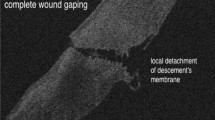Abstract
Purpose
To evaluate by Environmental Scanning Electron Microscopy (ESEM) the corneal incision architecture after intraocular lens (IOL) implantation in pig eyes, using manual, automated injectors or preloaded delivery systems.
Methods
Twenty-four pig eyes underwent IOL implantation in the anterior chamber using three different injectors: manual (Monarch III) (n = 8), automated (AutoSert) (n = 8), or a preloaded system (UltraSert) (n = 8). Acrysof IQ IOLs, 21 Dioptres (D) (n = 12) and 27D (n = 12), were implanted through 2.2 mm clear corneal incisions. Incision width was measured using corneal calipers. The endothelial side of the incision was analyzed with ESEM.
Results
In each group, the final size of the corneal wound after IOL implantation, measured by calipers, was 2.3–2.4 mm. The incision architecture resulted more irregular in the Monarch group compared with the other injectors. In every group the 27D IOL-implanted specimens showed more alterations than in 21D IOL-implanted samples, and this was less evident in the UltraSert group. The Descemet tear length was higher in the Monarch group than AutoSert and UltraSert group.
Conclusions
The automated and preloaded delivery systems provided a good corneal incision architecture; after high-power IOL implantation the incisions were more regular and less damaged with the preloaded system than with the other devices.


Similar content being viewed by others
References
Hayashi K, Yoshida M, Hayashi H (2009) Postoperative corneal shape changes: microincision versus small-incision coaxial cataract surgery. J Cataract Refract Surg 35:233–239
Weikert MP (2006) Update on bimanual microincisional cataract surgery. Curr Opin Ophthalmol 17:62–67
Calladine D, Packard R (2007) Clear corneal incision architecture in the immediate postoperative period evaluated using optical coherence tomography. J Cataract Refract Surg 33:1429–1435
ESCRS Endophthalmitis Study Group (2007) Prophylaxis of postoperative endophthalmitis following cataract surgery: results of the ESCRS multicenter study and identification of risk factors. J Cataract Refract Surg 33:978–988
Cooper BA, Holekamp NM, Bohigian G, Thompson PA (2003) Case-control study of endophthalmitis after cataract surgery comparing scleral tunnel and clear corneal wounds. Am J Ophthalmol 136:300–305
Wallin T, Parker J, Jin Y, Kefalopoulous G, Olson RJ (2005) Cohort study of 27 cases of endophthalmitis at a single institution. J Cataract Refract Surg 31:735–741
Steinert RF, Deacon J (1996) Enlargement of incision width during phacoemulsification and folded intraocular lens implant surgery. Ophthalmology 103:220–225
Kohnen T, Lambert RJ, Koch DD (1997) Incision sizes for foldable intraocular lenses. Ophthalmology 104:1277–1286
Kohnen T, Kasper T (2005) Incision sizes before and after implantation of 6-mm optic foldable intraocular lenses using Monarch and Unfolder injector systems. Ophthalmology 112:58–66
Berdahl JP, DeStafeno JJ, Kim T (2007) Corneal wound architecture and integrity after phacoemulsification Evaluation of coaxial, microincision coaxial, and microincision bimanual techniques. J Cataract Refract Surg 33:510–515
Jun B, Berdahl JP, Kuo AN, Cummings TJ, Kim T (2010) Corneal wound architecture and integrity after torsional and mixed phacoemulsification: evaluation of standard and microincisional coaxial techniques. Ophthalmic Surg Lasers Imaging 41:128–134
Ouchi M (2012) Effect of intraocular lens insertion speed on surgical wound structure. J Cataract Refract Surg 38:1771–1776
Allen D, Habib M, Steel D (2012) Final incision size after implantation of a hydrophobic acrylic aspheric intraocular lens: new motorized injector versus standard manual injector. J Cataract Refract Surg 38:249–255
Khokhar S, Sharma R, Patil B, Aron N, Gupta S (2014) Comparison of new motorized injector vs manual injector for implantation of foldable intraocular lenses on wound integrity: an ASOCT study. Eye 28:1174–1178
Weikert MP, Wang L, Barrish J, Dimalanta R, Koch DD (2012) Quantitative measurement of wound architecture in microincision cataract surgery. J Cataract Refract Surg 38:1460–1466
Bang JW, Lee JH, Kim JH, Lee DH (2015) Structural analysis of different incision sizes and stromal hydration in cataract surgery using anterior segment optical coherence tomography. Korean J Ophthalmol 29:23–30
Danilatos GD (1993) Environmental scanning electron microscope: some critical issues. Scanning Microsc Suppl 7:57–80
Danilatos GD (1985) Design and construction of an atmospheric or environmental SEM (part 3). Scanning 7:26–42
Nanavaty MA, Kubrak-Kisza M (2017) Evaluation of preloaded intraocular lens injection systems: ex vivo study. J Cataract Refract Surg 43(4):558–563
Author information
Authors and Affiliations
Corresponding author
Ethics declarations
Conflict of interest
David Allen is a paid consultant to Alcon Laboratories. The other authors declare no conflict of interest.
Ethical approval
This ex vivo study was conducted on pig cadaver eyes (whole globes), obtained from the abattoir Italpork S.r.l. (Borgo a Buggiano, Italy), and it did not involve live animal subjects; it followed the tenets of the Helsinki Declaration. All applicable international, national, and institutional guidelines for the care and use of animals were followed.
Rights and permissions
About this article
Cite this article
Mencucci, R., Favuzza, E., Salvatici, M.C. et al. Corneal incision architecture after IOL implantation with three different injectors: an environmental scanning electron microscopy study. Int Ophthalmol 39, 397–403 (2019). https://doi.org/10.1007/s10792-018-0825-2
Received:
Accepted:
Published:
Issue Date:
DOI: https://doi.org/10.1007/s10792-018-0825-2




